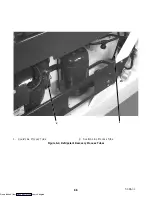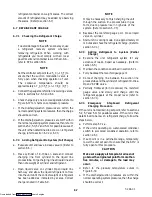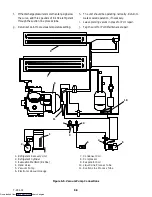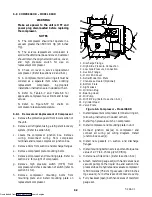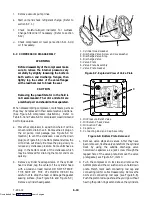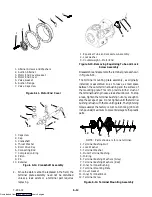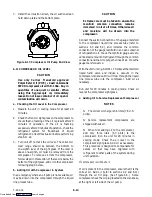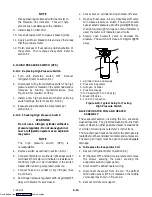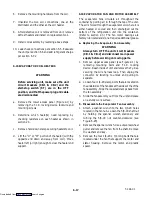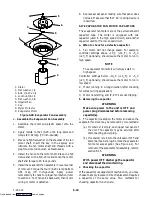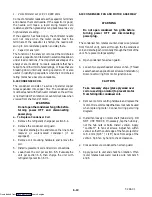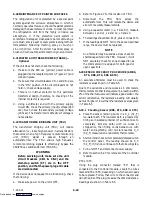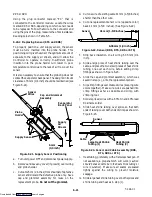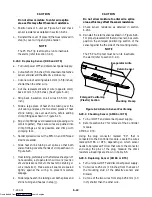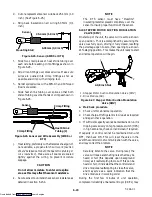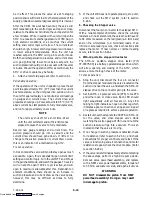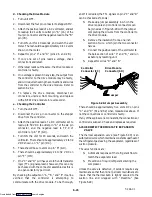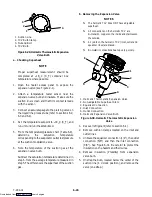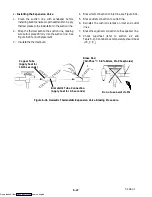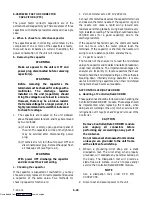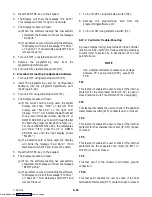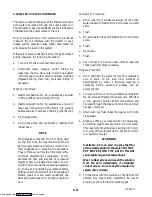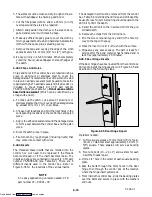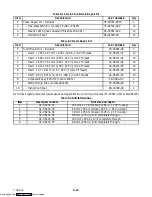
6-19
T-294-01
1. Volt-ohmmeter set on RX 10,000 ohms.
Connect ohmmeter leads across the capacitor terminals
and observe the meter needle. If the capacitor is good,
the needle will make a rapid swing toward zero
resistance and then gradually swing back toward a very
high resistance reading.
If the capacitor has failed open, the ohmmeter needle
will not move when the meter probes touch the
terminals. If the capacitor is shorted, the needle will
swing to zero resistance position and stay there.
2. Capacitor analyzer:
The function of the analyzer is to read the microfarad
value of a capacitor and to detect insulation breakdown
under load conditions. The important advantages of a
analyzer are its ability to locate capacitors that have
failed to hold their microfarad ratings, or those that are
breaking down internally during operation. It is also
useful in identifying capacitors when their microfarad
rating marks have become unreadable.
6.18 CONDENSER COIL
The condenser consists of a series of parallel copper
tubes expanded into copper fins. The condenser coil
must be cleaned with fresh water or steam so the air flow
is not restricted. Fan rotation is counterclockwise when
viewed from shaft end of motor.
WARNING
Do not open the condenser fan grille before
turning power OFF and disconnecting
power plug.
a. To Replace Condenser Coil
1. Remove the refrigerant charge per section 6.4.
2. Remove the condenser coil guard.
3. Unsolder discharge line and remove the line to the
receiver or water-cooled condenser (if so
equipped).
4. Remove coil mounting hardware and remove the
coil.
5. Install replacement coil and solder connections.
6. Leak-check the coil per section 6.5. Evacuate the
unit per section 6.6, then charge the unit with
refrigerant per section 6.7.1.
6.19 CONDENSER FAN AND MOTOR ASSEMBLY
WARNING
Do not open condenser fan grille before
turning power OFF and disconnecting
power plug.
The condenser fan rotates counter-clockwise (viewed
from front of unit), pulls air through the the condenser
coil, and discharges horizontally through the front of the
unit. To replace motor assembly:
a. Open condenser fan screen guard.
b. Loosen two square head set screws on fan. (Thread
sealer has been applied to set screws at installation.)
Disconnect wiring from motor junction box.
CAUTION
Take necessary steps (place plywood over
coil or use sling on motor) to prevent motor
from falling into condenser coil.
c. Remove motor mounting hardware and replace the
motor. It is recommended that new locknuts be used
when replacing motor. Connect wiring per wiring
diagram.
d. Install fan loosely on motor shaft (hub side in). DO
NOT USE FORCE. If necessary, tap the hub only,
not the hub nuts or bolts. Install venturi. Apply
“Loctite H” to fan set screws. Adjust fan within
venturi so that the outer edge of the fan projects 3.2
to 6.4 mm (3/16”
¦
1/16”) back from edge of the
venturi. Spin fan by hand to check clearance.
e. Close and secure condenser fan screen guard.
f. Apply power to unit and check fan rotation. If fan
motor rotates backward, reverse wire numbers 5
and 8.
Downloaded from
Содержание 69NT40-511-200
Страница 63: ...4 3 T 294 01 Page is left intentionally blank Downloaded from ManualsNet com search engine ...
Страница 117: ...7 2 T 294 01 Figure 7 1 Electrical Schematic See Model Chart Sheet 1 of 2 Downloaded from ManualsNet com search engine ...
Страница 119: ...7 4 T 294 01 Figure 7 2 Electrical Schematic See Model Chart Sheet 1 of 2 Downloaded from ManualsNet com search engine ...

